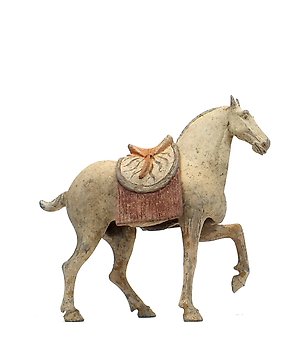
Oldtidens Kina Terrakotta Fremragende par malede keramikfigurer af skridende heste med aftagelige sadler, med to TL-tests, - 35.5 cm
Nr. 82434769

Nr. 82434769

Massive Pair of Painted Pottery Figures of Court Ladies – Fat Ladies, High 61 cm!
China, Tang dynasty, mid-8th century
Xián, Shaanxi province
Provenance: from private collection, EU.
Height: 60 and 61 cm.
A pottery figures of a court ladies, dressed in a long-sleeved, high-waisted robe that falls in pleats to the floor and covers their left foot, whilst their right foot is exposed, showing their pointed shoes. The pair stand on a square base and holds both hands in front of the ladies. The left hand of one lady is hidden inside the sleeve, whilst the fingers of her right hand are revealed. Their hair is gathered into an elaborate arrangement and is tied up loosely into a double bun. The red pottery is completely covered in a thin layer of white slip and the delicate features of their faces are painted with red, pink, and black highlights, including a painted flower on their forehead. Elaborate traces of black and red pigment can be seen on the clothes.
Our Guarantee: The above item is guaranteed to be of the time period and condition as described, has been exported legally and is legal to buy and sell under all international lows to cultural patrimony.
Note: It will be professionally packed and safely sent in a wooden crate within 3 working days by FedEx. Shipped with Insurance!
- All items legal to buy/sell under The Netherlands covering cultural patrimony and are guaranteed to be as described or your money back.
Tang Dynasty
National unification during the Tang dynasty brought about centuries of social stability and economic prosperity. Ceramic art evolved further towards maturity and important kiln centres emerge across the country.
The repertoire of mortuary objects in Tang tombs closely followed those of earlier periods. The majority was still made of pottery clay and came in many forms and styles, which illustrate the evolution and traits of Tang ceramic art. These objects can broadly be divided into five categories namely tomb guardians, guards of honour, attendants, animals, and utilitarian wares.
Tang dynasty tomb figures are pottery figures of people and animals made in the Tang dynasty of China (618–906) as grave goods to be placed in tombs. There was a belief that the figures represented would become available for the service of the deceased in the afterlife. The figures are made of moulded earthenware with colour generally being added, though often not over the whole figure, or in naturalistic places. Where the colouring was in paint it has often not survived, but in many cases, it was in sancai ("three-colour") ceramic glaze, which has generally lasted well.
The figures, called mingqui in Chinese, were most often of servants, soldiers (in male tombs) and attendants such as dancers and musicians, with many no doubt representing courtesans. In burials of people of high rank there may be soldiers and officials as well. The animals are most often horses, but there are surprising numbers of both Bactrian camels and their Central Asian drivers, distinguished by thick beards and hair, and their facial features. The depictions are realistic to a degree unprecedented in Chinese art, and the figures give archaeologists much useful information about life under the Tang. There are also figures of the imaginary monster "earth spirits" and the fearsome human Lokapala (or tian wang), both usually in pairs and acting as tomb guardians to repel attacks by both spirits and humans. Sets of the twelve imaginary beasts of the Chinese Zodiac are also found, usually unglazed.
The most common animals, and the most likely to be large and carefully modelled and decorated, are horses and camels. Both sorts range from animals without harness and saddlery to those with elaborately detailed trappings, and carrying riders or, in the case of camels, heavy loads of goods.
The graceful ladies with plump faces and bodies (so called Fat ladies), the smartly dressed civil officials, the mighty warriors, the horses with saddles and accessories, as well as camels and non - Chinese figurines are all results of the potter’s keen observation and superb virtuosity. They allow us to visualise life in China more than a millennium ago.
Condition: Very good condition. Wear consistent with the age, some loss of color and cracks. Please be advised that all ancient Chinese pottery objects had been buried in tombs and are excavated from there. Therefore, they can always have some restorations. Also worth of note is that the item is more than 1200 years old.
Important information.
The seller guarantees that he is entitled to ship this lot.
It will be professionally packed and safely send by FedEx. Shipped with Insurance!
Buyers are responsible for import regulation and restrictions of their own country.
Sådan køber du hos Catawiki
1. Opdag noget særligt
2. Afgiv det højeste bud
3. Foretag en sikker betaling